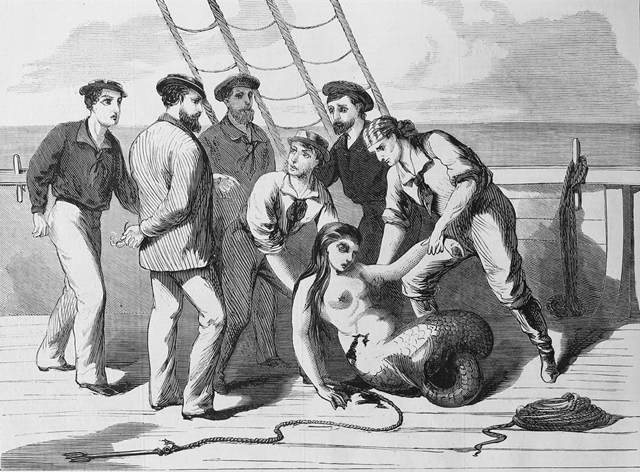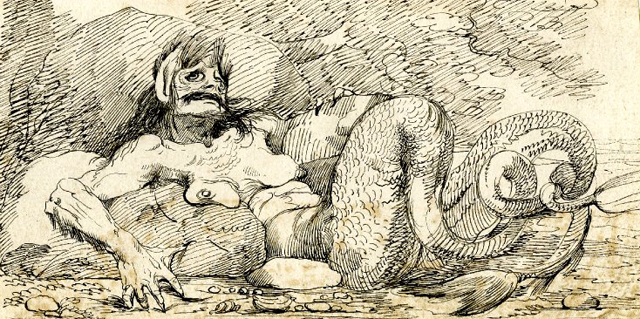Here be sea monsters
by Aaron ThierIn the year 1560, near the island of Mannar on the west coast of what was then Ceylon, a group of Dutch fishermen caught seven mermaids and seven tritons. By some marvellous chance, the personal physician to the Viceroy of Goa was on board the vessel at the time of their capture, and he dissected the creatures and affirmed their astonishing likeness, both internal and external, to human beings. Although mermaids had been known since remote antiquity, this was the first occasion upon which a modern man of science had an opportunity to observe them in something like their natural condition.
Mermaids, which have been driven to extinction in our own time, were once common in the Mediterranean, where they were feared and reviled by Greek sailors, and in the great age of sail there were vast shoals of them in the north Atlantic. These creatures remained almost unknown to landsmen, however, probably because sailors were either superstitious about catching them, and believed that to have a mermaid on board was to bring ruin to a ship, or else, if they were not superstitious, tended to eat the mermaids they did catch.
It should also be noted that the Ceylon mermaids, of which no description survives, were unusual in that they were caught within the tropics. Mermaids typically did not occur beneath the twentieth parallel in either hemisphere, probably because tropical oceans are substantially less productive than oceans at higher latitudes. The mermaids and mermen captured off Ceylon had probably been living near a coral reef or else hunting for their food in a shallow littoral zone where coastal run-off enhanced marine productivity.
When one begins to examine the historical record, the first thing one notices is that the genus Halicora, to which all mermaids are thought to have belonged, appears to have been extraordinarily diverse.”
And yet any statement about the behaviour and distribution of mermaids is conjectural. Perhaps the Ceylon mermaids were in the process of migration. Perhaps they were a distinct tropical subspecies. When one begins to examine the historical record, the first thing one notices is that the genus Halicora, to which all mermaids are thought to have belonged, appears to have been extraordinarily diverse. Consider the following well-substantiated accounts:
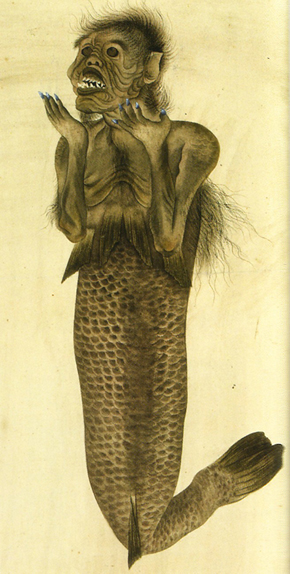
Japanese mermaid illustration from the National Museum of Ethnology in Leiden, Netherlands obtained by Dutch trader Jan Cock Blomhoff, who was posted in Nagasaki from 1817 to 1824
In 1610, while walking by the riverside in the harbour of St John’s, at Newfoundland, Captain Richard Whitbourne observed a mermaid watching him from the water. The captain affirmed that the creature was very much like a woman, indeed beguilingly so, and yet in place of hair it had blue streaks on its head.
In 1758, a mermaid was exhibited at the fair of St Germain. It was two feet long, female, and hideously ugly. It had arms like those of a human and a tail like that of a fish. It had enormous ears. It was almost entirely covered with scales.
In June 1761, two girls discovered a mermaid in a natural grotto on the island of Noirmontier. Mistaking the animal for a human, one of the girls plunged her knife into it, whereupon it cried out just as a human would have done. The girls then cut off its hands, which had webbed fingers. A physician on the island examined the animal and reported that it was as large as the largest man, with white skin like that of a drowned person, a beard of shells, a flat nose, a large mouth and enormous, beautiful breasts. It had a tail like that of a fish, but at the extremity of the tail were two feet.
As recently as 1811, a young man from the town of Corphine in Scotland swore before a magistrate that he had seen a mermaid sitting upon a black rock near the shore. The animal was human from the waist up, though its arms were shorter in proportion than they ought to have been, and the tail below was a reddish green, delicate and tapering. The animal was stroking its hair, which was light brown in colour. After tumbling into the sea, it rose to the surface and began stroking its breasts as well. Mermaids of the same description have also been seen in the river at Berbice, where their skin is said to be tawny. At Berbice, too, they occupy themselves in stroking their hair and breasts.
In about the year 1710, a mermaid of a very different description was seen in the river Ex, near Exeter. It was, like other mermaids, human from the waist up, with a tail like that of a salmon, and yet it also had two legs upon which it attempted to flee from a group of local men who chased it out of the water. Before it was knocked to the ground and beaten to death, it was said to have screamed in terror, making it yet more unusual among mermaids, which were almost always described as mute.
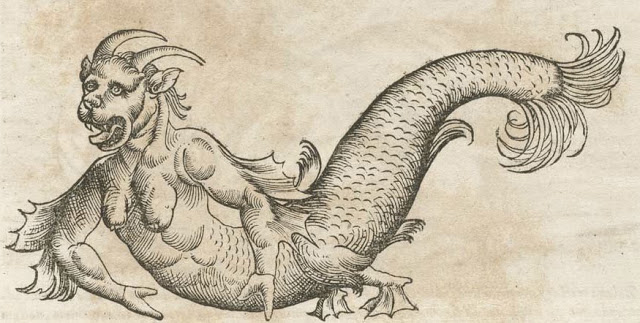
Sea monster from Conrad Gesner’s Historiae Animalium (Zürich, 1551–87), considered to be the first modern zoological work
Indeed, muteness was sometimes the only characteristic that distinguished the merperson from the man, for some mermaids and mermen had no tails at all. On the coast of Suffolk in 1187, fishermen hauled up a merman that was said to be just like a human being in every particular except that it could not speak. It was taken to the castle at Oreford, and there, under the direction of Sir Barthelomuo de Glanuille, hung up by its heels and tortured, and still it made no sound. It lived for six months in the castle and never uttered a word. One peculiarity of its diet is given: When it was presented with raw fish, it pressed each piece between his hands until it had expelled all the moisture, and only then did it eat.
Another tailless mermaid was discovered in a field in West Friesland, having been washed ashore when the sea overtopped the dykes. It lived for years afterward at Haarlem, where it was occupied in quiet domestic work. It too was mute, but it is said to have been a good Christian, and made the proper obeisance whenever it passed a cross.
From these accounts, and innumerable others, one can only conclude that there were as many species and subspecies of mermaids as there were fish in the sea. There were mermaids with soft grey skin, and others with rough skin like that of a shark, and still others with fine rainbow scales, and even one, described by a Mr Toupin of Exeter, with feathers. Some mermaids had a fin running from between the eyes, up over the head, down the neck, and all the way to the lower back. Some had tails like salmon, and some had tails like porpoises, and some had long ventral fins. Some had webbed fingers. Some had seaweed for hair. Some had very short necks and mouths large enough to admit a man’s fist. All of them seem to have had breasts, however, by all accounts quite remarkable breasts, though some allowance must be made for the inevitable inventions of lonely sailors.
The disappearance of mermaids in our own time is ascribed to numerous causes. To the warming oceans, to pollution, to the overfishing of those species upon which mermaids subsisted, and to the accidental capture of mermaids by vast fishing fleets.”
Perhaps all one can say for certain is that mermaids did not sing, despite the stories that come down to us from the ancients. A distinguished naturalist has demonstrated that the haunting melodies said to have driven sailors mad were nothing but the peculiar musical notes produced by a certain kind of shellfish, entirely unrelated to mermaids.
The disappearance of mermaids in our own time is ascribed to numerous causes. To the warming oceans, to pollution, to the overfishing of those species upon which mermaids subsisted, and to the accidental capture of mermaids by vast fishing fleets. The truth probably comprehends some combination of these factors, and thus the transit and eclipse of the mermaid becomes yet another figure for the devastation man has wrought upon his world.
And yet, alarming and upsetting as their disappearance may be, it is to the ultimate origin of mermaids that the greatest controversy still attaches. Many explanations have been proposed, some of them quite fantastic. Some writers argue that mermaids derive from fallen angels who were cast from heaven into the sea. Others say that the devil begat mermaids when he raped a shark. Still others say that certain fish were so stirred by the sight of men and women drowning during the deluge that they acquired some human features simply by force of imagination.
But there exists a more rational explanation, one that becomes increasingly irresistible the more one reads of the mermaid’s perfect bosom. Mermaids and mermen, by all accounts, copulated as dolphins and porpoises do, belly to belly, and there is therefore no anatomical reason why a man should not have had intercourse with a mermaid. Indeed, considering the length of many voyages in the age of sail – and notwithstanding the great violence that seems to have attended so many encounters with these visitors from the watery abyss – it would have been astonishing if such a thing never occurred.
Working backwards, therefore, from the assumption that a young sailor in a transport of lust would have been unlikely to trouble himself about something so negligible as a tail, it seems perfectly credible that a man in some even greater extremity might have looked upon a porpoise with similar intentions. And thus we arrive at an explanation not only for the origins of mermaids, but for their great diversity: In remote prehistory, a man contrives to have a romantic encounter with a porpoise. The offspring of this monstrous union is neither man nor fish, and in its turn it engenders a second generation of hybrid creatures, three quarters porpoise and one quarter human, should it have congress with another porpoise, or three quarters human and one quarter porpoise should it succeed in seducing another man. And so it continues, generation after generation.
Living as we do in a benighted time, and lamenting the extermination of so many marvellous creatures, we may derive some comfort from this progression, for if sailors now and then succumbed to the charms of mermaids – and, of course, in the early days, of porpoises too – then perhaps, at some time and in some place, or at many times and in many places, a lonely woman gave herself to a merman, or even to a porpoise, for it is no secret that women are also prey to monstrous lusts. Like her counterpart in the sea, such a woman might then have given birth to a child not man and not fish but something in between, distinguished from other mermaids or proto-mermaids only by its residence on land. And if its peculiarities were not of a nature too repulsive to warn off any potential mates, this creature would have combined and recombined with other humans or perhaps other land animals, and thus a race of terrestrial mermaids would have arisen, linked and yet gradually diverging from their kindred in the sea.
That such a thing must have occurred, even if the original admixture of porpoise blood was subsequently diluted to an almost negligible proportion, is perfectly plain when one considers that there are people whose palms are perpetually damp, or who evince great skill in swimming even while they move without grace on dry land. Thus we may console ourselves with the knowledge that the mermaid, like the American Indian, like the Neanderthal, is in some respects not extinct at all, but simply transfigured, and lives on in us as part of our obscure and varied legacy.
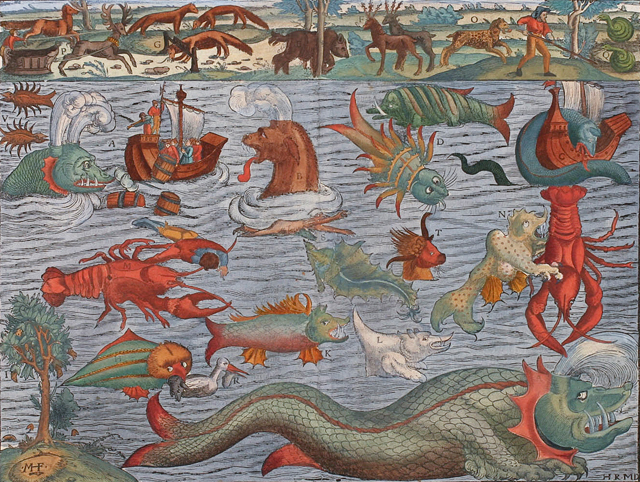
Plate depicting various sea monsters from the Carta Marina by Olaus Magnus, c. 1544. Sebastian Münster/Wikimedia Commons
 Aaron Thier’s writing has appeared in The Nation, The New Republic, and The Buenos Aires Review. He is a graduate of Yale University and of the MFA program at the University of Florida. He lives with his wife in western Massachusetts. His first novel, The Ghost Apple, a sparkling and tender satire about the enduring effects of colonisation in the Carribean, is published by Bloomsbury in hardback and eBook. Read more.
Aaron Thier’s writing has appeared in The Nation, The New Republic, and The Buenos Aires Review. He is a graduate of Yale University and of the MFA program at the University of Florida. He lives with his wife in western Massachusetts. His first novel, The Ghost Apple, a sparkling and tender satire about the enduring effects of colonisation in the Carribean, is published by Bloomsbury in hardback and eBook. Read more.
aaron-thier.com

